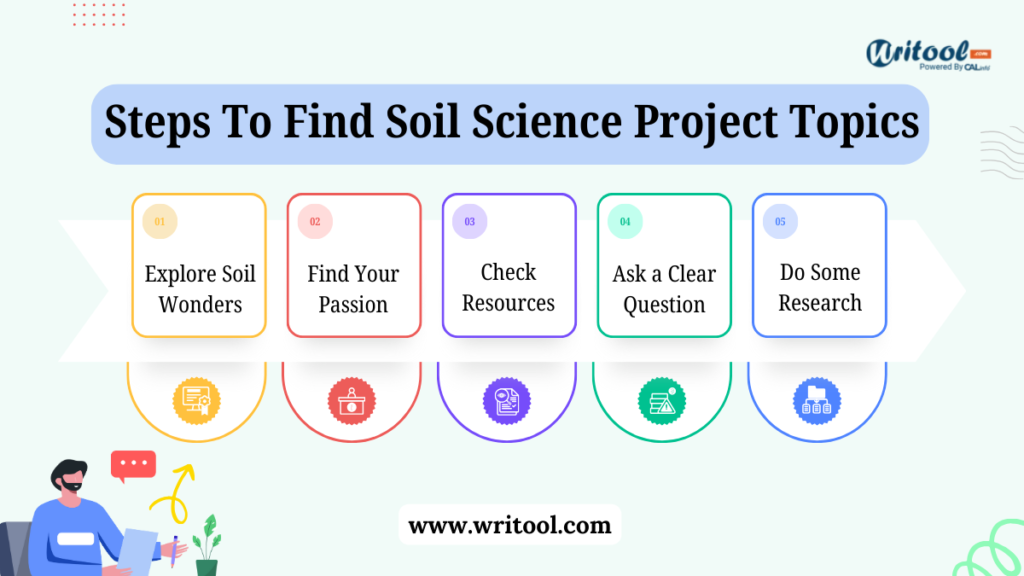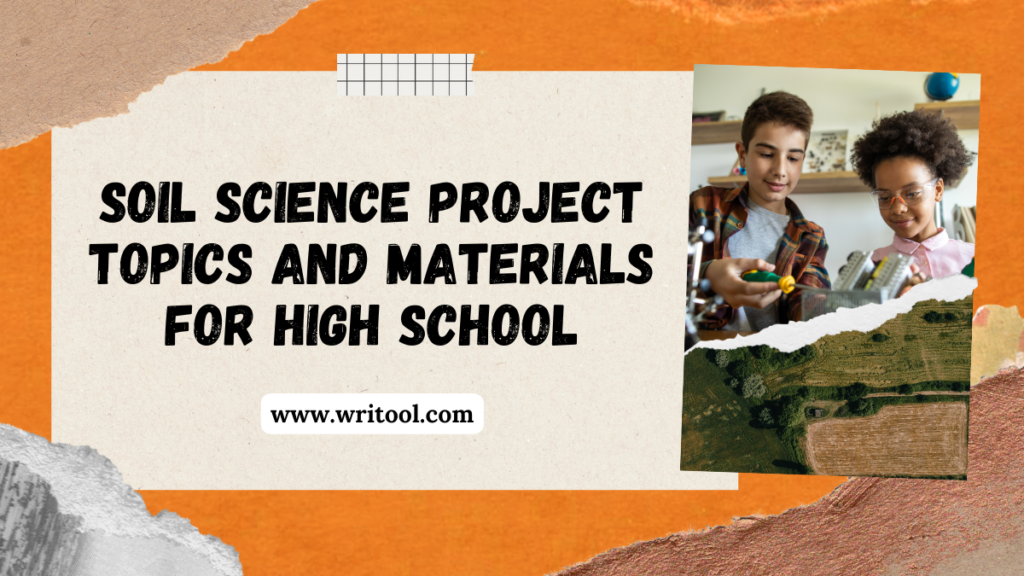Looking for something interesting and exciting soil science project topics and materials for high school? High school is the perfect time to explore soil science.
Here are some practical and engaging project topics and materials to kickstart your exploration. For instance, you could investigate how different soil types impact plant growth, a project that has direct relevance to our agricultural practices.
Or perhaps you’re interested in studying the role of soil erosion and conservation methods. You could design experiments to simulate erosion and test different techniques to prevent it.
Another idea is to explore the relationship between soil health and water quality. By testing water samples from areas with different soil conditions, you can uncover how soil impacts the quality of our water sources.
Let’s find out an in-depth guide for soil science and explore more about it.
What Is Soil Science Project Topics?
Soil science is the study of the ground beneath our feet. It is a living ecosystem that affects plant growth, shapes landscapes, and even stores carbon.
A soil science project topic is a question you’ll explore about soil. It could be about how different types of soil affect plants, the tiny creatures that live in the soil, or even how cities change soil quality.
These project ideas will help you dig deep and discover the fascinating world of soil.
Steps To Choose Good Soil Science Project Topics And Materials For High School
Searching for a soil science project for high school? Let’s know some simple and fun steps to find a good soil science project. Here’s how to get started:

Step 1: Explore Soil Wonders
Learn about soil’s cool stuff: Get to know its layers, chemistry, and tiny inhabitants like microbes. This will spark your project ideas.
Step 2: Find Your Passion
What interests you most? Are you into plant growth, underground critters, or environmental issues like erosion? Pick a topic that excites you.
Step 3: Check Resources
Think about what you need: Can you get the materials and time for your project? Make sure it’s doable.
Step 4: Ask a Clear Question
What do you want to find out? Ask a clear question like, “How does soil pH affect plants?” or “Do different mulches change soil temperature?”
Step 5: Do Some Research
Check what’s already known: Read up on your topic to see what scientists have discovered.
Step 6: Get Your Gear
Make a list of what you need: Soil samples, plants, and testing kits – gather it all up.
Step 7: Get Creative
Make your project stand out: Use models, visuals, or a cool presentation to show off your findings.
Follow these steps, and you’ll have an awesome soil science project that shows off your curiosity and creativity.
List 27+ Best Soil Science Project Topics And Materials For High School
Explore the interesting soil science project topics and materials for high school. From investigating soil pH’s impact on plant growth to studying soil erosion’s effects and conservation methods. Here, we cover all the topics of the best soil science research papers.
1. Effect of pH of the Soil on Plant Growth
Compare tomato development in alkaline soil to dry regions and acidic soil to that found in places with abundant rainfall.
2. Ecology and Conservation Techniques
Analyse erosion rates in a nearby park or agricultural field, contrasting regions with and without terracing or cover crops as erosion control techniques.
3. Water Filtration Effects of Various Soil Types
Compare samples of sand, clay and loam to see how effectively the soil types that are typical in your region filter rainfall runoff.
4. Microbes in the Soil and Their Decomposition
Organise a decomposition experiment in which you use soil from a backyard compost bin and organic products to track microbial activity.
5. Sustaining Plant Growth and Soil Nutrient Content
Check the soil’s nutrient content from a neighborhood garden and link it to the development of various food crops.
6. How Compaction of the Soil Affects Plant Growth
Analyze how the soil’s compaction levels at a nearby park or sports field impact the development of grass or other plants.
7. Pollution of the Soil and Methods of Remediation
Examine soil samples from an industrial or brownfield site, then evaluate the efficacy of various remediation techniques, including phytoremediation.
8. Texture of the Soil and Retention of Water
Get soil samples from many locations around your school to find out which kind of soil holds water the best for landscaping or gardening.
9. Plant Growth with Soil Salinity
Examine how runoff of road salt affects soil salinity levels in regions close to roads or highways, and note how it affects the vegetation in the vicinity.
10. The Fertility Of Soil Is Affected By Soil Amendments
See whether compost or organic fertilizers work best in a school garden by conducting an experiment.
11. Growth of Plants and Variations in Soil Temperature
Calculate the soil temperatures in a garden or field’s sunny and shaded sections and link them to the rates of plant development.
12. Plant Health: The Impact of Soil Moisture Levels
Track the amount of moisture in a vegetable garden both during dry and rainy spells to see how they affect crop health and productivity.
13. Microbial Diversity and Soil Composition: An Overview
To investigate the impacts of human activity, contrast the microbial diversity in soil from a playground or urban park with that from a forest.
14. pH of Soil and Availability of Nutrients
Find out how acid rain-affected and unaffected locations’ soil pH levels impact plant health and nutrient absorption.
15. Biological Soil Remediation
From a previous industrial site, native plants are used in a bioremediation operation to clean up soil tainted with heavy metals or oil.
16. Vermicomposting
Kitchen wastes may be used to start a vermicomposting bin at school, and you can see how earthworm activity gradually improves the quality of the soil.
17. Carbon Sequestration With Soil Organic Matter
Find out how much soil carbon is in a nearby park or forest to show how organic matter helps to store carbon and slow down climate change.
18. In Plant Nutrition, the Function of Mycorrhizal Fungi
In a controlled experiment, plant roots were inoculated with mycorrhizal fungus, and plant growth and nutrient absorption results were tracked.
19. Aeration of the Soil’s Effects on Plant Growth
To illustrate the value of soil structure, contrast the development of grass or other plants in aerated soil with that in compacted soil.
20. Soil Acidification and Alkalinity
In regions impacted by acid mine drainage or agricultural runoff, measure soil pH values to investigate how soil acidification affects nearby ecosystems.
21. Different Mulches’ Retention of Soil Moisture
Find out which mulch in a garden or landscape best conserves water by measuring the soil moisture levels underneath it.
22. Amendments to Soil and Absorption of Heavy Metals
Determine how well certain soil amendments work to lower the levels of heavy metals in polluted soil from a previous industrial site.
23. Fertility of the Soil and Cover Cropping
Plant cover crops in a school garden, then track during a growing season how they affect soil fertility, erosion management, and weed suppression.
24. Soil Depth’s Impact on Plant Root Development
In a garden or field, dig soil pits of different depths and investigate how soil depth affects plant health and root development.
25. Aggregates Of Soil And Water Seepage
In a field or garden, quantify soil aggregate stability and track its relationship with rates of water infiltration.
26. Tillage Techniques’ Impact on Soil Structure
Compare the impacts on soil structure, erosion, and crop output of no-till farming, traditional plowing, and various tillage techniques.
27. Evaluation of the Health of the Soil Using Indicators of Soil Quality
To determine the general condition of the soil in many parts around your school and to pinpoint the elements influencing soil quality, use soil health test kits.
These actual cases will increase the interest and relevance of the soil science projects to the experiences and surroundings of the students.
Why Do We Study Soil Science?
We study soil science for many reasons, but it all comes down to one thing: soil is essential for life on Earth. Here’s why it’s so important:
- Food Security: Healthy soil is crucial for growing healthy food. Learning about soil helps us keep it fertile and productive, ensuring we have enough food for everyone.
- Environmental Health: Soil helps clean water, control climate, and store carbon. Understanding soil science helps us keep the soil clean and healthy, which benefits all living things.
- Sustainable Land Use: Soil science guides how we use land sustainably. This means using it in ways that meet our needs without harming its future ability to support life.
- Better Plants: Different soils affect how well plants grow. Knowing this helps us grow more food and keep plants healthy.
- Fighting Climate Change: Soil stores a lot of carbon dioxide, a gas that contributes to climate change. Studying soil science helps us find ways to store even more carbon in soil, which helps fight climate change.
By understanding soil, we can make smart choices about how we use it. This helps keep our planet healthy, ensures we have enough food, and builds a better future for everyone.
Cool Soil Science Project Topics And Materials For High School PDF
Here are the soil science research paper PDF for students:
Top 10 Recent Soil Science Research Topics In 2024
Dive into the world of soil science with these easy and practical research ideas. From learning how tiny bugs in soil affect plants to understanding how soil helps feed us all, these projects offer exciting insights into why soil matters for our planet’s health and food supply.
| Rank | Topic | Soil Science Project Topics And Materials For High School |
| 1 | Soil Bugs and Plant Health | Learn how tiny organisms in soil affect plant growth, disease resistance, and nutrient absorption. |
| 2 | Trapping Carbon in Soil | Explore ways to store more carbon in soil, fighting climate change while making soil healthier. |
| 3 | Smart Farming and Soil Mapping | Use technology to make detailed maps of soil, helping farmers use fertilizers and resources wisely. |
| 4 | Cleaning Polluted Soil with Bugs | Study how soil bugs can clean up pollution, offering a natural way to make polluted land healthy again. |
| 5 | How Climate Change Affects Soil | See how changing weather affects soil quality, which impacts farming and nature. |
| 6 | Keeping Soil Healthy on Farms | Look at ways to keep soil healthy on farms for better crops and a greener planet. |
| 7 | Urban Soil: Cities and Dirt | Check out what makes city soil different and how we can make it better despite all the buildings and roads. |
| 8 | Dirt’s Role in Feeding Everyone | Find out how taking care of soil helps us grow more food and have a steady food supply. |
| 9 | Bug Fertilizers from Soil | Explore using tiny bugs in soil to make plants grow better, which means less need for chemical fertilizers. |
| 10 | Playing with Dirt: Computer Edition | Use computers to pretend with soil, helping us understand how soil works and how to take care of it better. |
Sum Up – Soil Science Project Topics And Materials For High School
That’s all about Soil science project topics and materials for high school. These projects let students explore the amazing world of soil.
From studying how tiny bugs in soil affect plants to learning how soil helps feed us all, these projects show why soil is so important.
They help students understand how to take care of the soil and why it’s vital for our planet’s health and food supply.
By doing experiments with simple materials, students not only learn more about science but also become more aware of how important it is to protect our environment.
So, let’s keep digging into the secrets of soil science, one project at a time.


